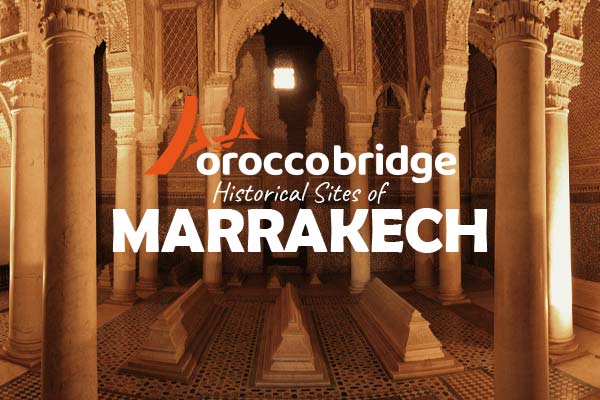Exploring the Majestic Palaces and Historical Sites of Marrakech – Marrakech is a city that blends ancient history, vibrant culture, and architectural splendor. From grand palaces to historic sites, the city offers a glimpse into Morocco’s royal past and its incredible heritage. If you’re a history lover or simply looking to soak in the beauty of Marrakech’s majestic landmarks, then this is the ultimate guide for you!
Let’s embark on a journey through the most iconic palaces and historical sites that will make you fall even more in love with Marrakech.
1️⃣ Bahia Palace – A Glimpse of Royal Splendor
Location: Medina, near the Mouassine Mosque
🔥 Why Visit? One of the finest examples of Moroccan architecture, Bahia Palace is a stunning example of what Moroccan royalty once called home. Built in the 19th century, the palace is known for its intricate tile work, stunning gardens, and spacious courtyards.
What to Expect:
✔️ Beautiful courtyards with lush gardens and fountains
✔️ Elaborate mosaic tiles and stucco work on the walls
✔️ Lavish rooms that once housed harem women, reflecting the opulence of the royal court
🔥 Pro Tip: Visit early in the morning to beat the crowds and enjoy the peaceful atmosphere!
2️⃣ El Badi Palace – A Ruin with a Story to Tell
Location: Kasbah Quarter
🔥 Why Visit? Though now in ruins, El Badi Palace was once one of the most magnificent palaces in Morocco. Built by Sultan Ahmad al-Mansur in the 16th century, it’s a stunning sight and a reminder of the city’s glorious past.
What to Expect:
✔️ Massive sunken gardens with pools and fountains
✔️ Impressive ruins that give you a sense of the palace’s former grandeur
✔️ Panoramic views of the city from the palace’s remains
🔥 Pro Tip: Look for the stork nests perched on top of the ruins—this palace is now home to a population of nesting storks!
3️⃣ Saadian Tombs – A Royal Burial Site
Location: Kasbah District, near the El Badi Palace
🔥 Why Visit? The Saadian Tombs are the final resting place of the Saadian dynasty and are among the most visited historical sites in Marrakech. Hidden for centuries and rediscovered in 1917, these tombs are an awe-inspiring testament to the city’s rich royal history.
What to Expect:
✔️ Elaborate tombs of Saadian rulers, their family members, and important courtiers
✔️ Decorative tilework and ornate carvings that tell a story of an ancient royal family
✔️ The Tomb of Ahmed al-Mansur, with its intricate stucco work and colorful mosaics
🔥 Pro Tip: Don’t rush—take your time to admire the craftsmanship and reflect on the history of the Saadian dynasty.
4️⃣ Koutoubia Mosque – A Majestic Landmark
Location: Near Jemaa el-Fnaa Square
🔥 Why Visit? One of Marrakech’s most iconic landmarks, the Koutoubia Mosque is a stunning example of Moroccan architecture and a symbol of the city. With its towering minaret and intricate decorative work, it’s a must-see for anyone visiting Marrakech.
What to Expect:
✔️ The 77-meter high minaret—a towering structure visible from all over the city
✔️ Beautiful gardens that provide a peaceful escape from the bustling city
✔️ Architectural details, like archways and tilework, that showcase Morocco’s design heritage
🔥 Pro Tip: While non-Muslims cannot enter the mosque itself, the gardens and surrounding area are worth visiting, and you’ll get an incredible view of the mosque from different angles.
5️⃣ Palais Moulay El Yazid – A Royal Residence Fit for Kings
Location: Kasbah Quarter
🔥 Why Visit? Built in the 16th century by Sultan Moulay Ismail, the Palais Moulay El Yazid is a magnificent palace with lush gardens and royal history. It’s less crowded than other landmarks, so you can explore its grandeur in peace.
What to Expect:
✔️ Luxurious rooms and royal courtyards showcasing the opulence of the 16th century
✔️ Stunning views of the city and surrounding areas from the palace’s towers
✔️ Beautiful architecture and decorative gardens that reflect Moroccan craftsmanship
🔥 Pro Tip: If you’re in the Kasbah area, take a detour and stroll through the nearby streets for a more intimate look at the ancient neighborhoods of Marrakech.
6️⃣ Jardin Majorelle – A Botanical Oasis with a Rich History
Location: Hivernage District
🔥 Why Visit? While not a palace, Jardin Majorelle is an iconic site and a beautiful garden that is historically significant. Designed by French artist Jacques Majorelle in the 1920s, the garden was later restored by fashion designer Yves Saint Laurent.
What to Expect:
✔️ Lush gardens filled with exotic plants and breathtaking colors
✔️ Majorelle Blue, the famous shade of blue that permeates the garden’s architecture
✔️ The Berber Museum housed within the garden, showcasing the culture and art of Morocco’s indigenous people
🔥 Pro Tip: The garden is a peaceful retreat, perfect for some quiet reflection and to enjoy the beauty of nature.
Final Thoughts: A Walk Through Marrakech’s Majestic History
Marrakech is a city that speaks through its palaces, tombs, and historical sites. Each building and monument holds a piece of Morocco’s rich cultural heritage and invites visitors to step back in time and explore the legacy of its rulers and artisans. Whether you’re marveling at the intricate tilework of Bahia Palace or exploring the ruins of El Badi Palace, there’s no shortage of places to uncover in this magical city.
Which historical site in Marrakech will you explore first? Drop your thoughts below!
Exploring the Majestic Palaces and Historical Sites of Marrakech
Important places to visit in Morocco:
- Rabat’s Best Beaches & Coastal Adventures
- Unforgettable Day Trip to Ouarzazate
- Hiking & Nature in Chefchaouen
- Essaouira: The Windy City’s Coastal Charm & Historic Medina


